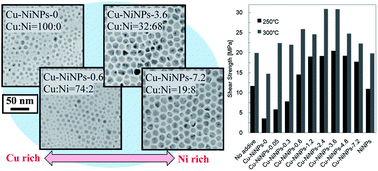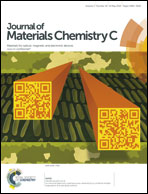Enhancement of pressure-free bonding with Cu particles by the addition of Cu–Ni alloy nanoparticles†
Abstract
Cu–Ni alloy nanoparticles (∼20 nm) were synthesized with precise control over the resulting Cu and Ni proportions. Nanoparticles composed of 29 wt% Cu and 71 wt% Ni exhibited significant resistance to surface oxidation and were readily sintered, suggesting that they could serve as bonding materials. The adhesive strength of Cu plates bonded by Cu particles of 150–200 nm in size was enhanced by adding these Cu–Ni alloy nanoparticles to the larger Cu particles. This is the first example of the use of base metal nanoparticles at a low-temperature (250 °C) under pressure-free conditions to achieve bonding strengths equivalent to those obtained when applying the standard Pb-free solder (Sn–Ag–Cu). Furthermore, a sintered Cu film with good electric conductivity was obtained using the mixture of Cu–Ni nanoparticles and Cu particles. The enhanced properties of these bonded layers were due to the formation of a densely sintered layer resulting from the addition of the Cu–Ni alloy nanoparticles to the Cu paste. This method could potentially have applications in the electrical packaging industry, since it represents a simple, economical process that results in highly conductive bonds.


 Please wait while we load your content...
Please wait while we load your content...